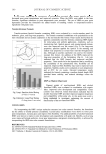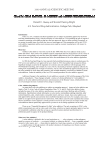SUNLESS TANNING FORMULATIONS 83 As for the “natural universe of suntan tonality,” measurements associated with X were within this realm, indicating that the sunless tan generated by X is comparable to a desir- able natural sun-induced tan for all panelists. Application of K resulted in three panelists being outside the “natural universe of suntan tonality” range. Two of the panelists devel- oped a color that was more yellow than natural suntan, while another panelist seemed to have less red than natural suntan. In addition, one of the fi ve panelists was outside the “natural universe of suntan tonality” range and another panelist had a less developed tan that was on the borderline of the range. Overall, the tonality of the sunless tan generated by K was less “natural” since three out of fi ve panelists were outside the “natural universe of suntan tonality” range. The majority of panelists preferred the sunless tanning experi- ence associated with X. Their subjective perceptions were: X produces a more natural, more even, and longer-lasting tan that was initially less intense versus K, which gener- ated slightly higher ΔE*ab values in 24 hours, but faded away faster after 48 hours. An HPLC method for the analysis of DHA levels in sunless tanning formulations was es- tablished and successfully utilized to confi rm DHA concentrations in the test articles. The sunless tanner market continues to grow rapidly, and our fi ndings can help to de- velop and evaluate new products with superior performance to fulfi ll consumers’ expecta- tions. ACKNOWLEDGMENTS We are grateful for the support of our colleagues at Ciba Corporation (part of BASF Group): Joseph Lupia, B. Scott Jaynes, Shawn O’Brian, and Sheila Loggins. REFERENCES (1) The Rose Sheet, 29(26), 9, (2008). (2) L. R. Robinson and P. R. Tanner, US patent 5,603,923, Artifi cial tanning compositions having improved color development (1997). (3) P. Lentini, N. Muizzuddin, E. Pelle, and L. Punto, US patent 5,503,824, Skin tanning compositions (1996). (4) P. D. Ziegler and B. A. Crotty, US patent 5,232,688, Self-tanner cosmetic compositions (1993). (5) O. Dueva-Koganov, T. Russo, and J. P. SaNogueira, US patent 7,378,084, Sunless tanning composition and method of sunless tanning (2008). (6) R. Jermann, M. Toumiat, and D. Imfeld, Development of an in vitro effi cacy test for self-tanning formu- lations, Int. J. Cosmet. Sci., 24, 1–8 (2002). (7) O. Dueva-Koganov, C. Rocafort, B. S. Jaynes, J. Lupia, B. Ridley, X. J. Zhou, and S. Barker, The impact of polymers in sunless tanning delivery systems (2007 SCC Annual Scientifi c Seminar), J. Cosmet. Sci., 59(2), 188–189 (2008). (8) http://www.ims-usa.com/ittrium/visit?path=A1x66x1y1xa0x1x65y1xc6x1x65y1xccx1x65 (9) N. Muizzuddin, K. D. Marenus, and D. H. Maes, Tonality of suntan vs. sunless tanning with dihy- droxyacetone, Skin Res. Technol., 6, 199–204 (2000). (10) P. A. Biondi, E. Passero, S. Soncin, C. Bernardi, and L. M. Chiesa, Selective determination of dihydroxy- acetone in self-tanning creams by HPLC as pentafl uorobenzyloxime derivative, Chromatographia, 65, 65–68 (2007). (11) A. Chardon, I. Cretois, and C. Hourseau, Colorimetric evaluation of the protection afforded by highly protective suntanning products, Proc. 16th IFSCC Cong., New York, poster presentation (1990).
Purchased for the exclusive use of nofirst nolast (unknown) From: SCC Media Library & Resource Center (library.scconline.org)





































































































































